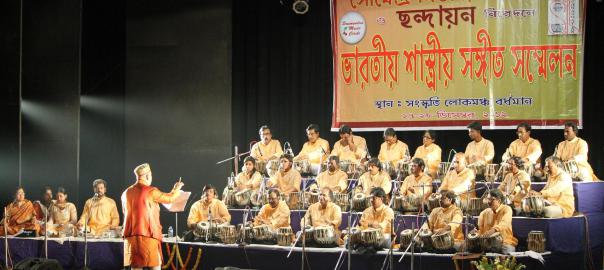Tablaphilia is a unique symphony of tabla. It is based on the central theme of Chaturashram, the four stages of human life. Composed and directed by renowned tabla maestro, Samir Chatterjee, this Symphony of Tabla brings together the power of 22 thundering tablas and four melodious vocals to produce a moving, inspiring and thought-provoking experience of the philosophy of sound.
This 70-minute piece interprets the four stages of human life (ashrams) as perceived and maintained in ancient Indian society. The first stage, Bramhacharya, identified as the student life, is meant to be dedicated to the pursuit of Brahma, the creator – our source and destination. In this stage, we are meant to be engaged solely in the pursuit of real knowledge and wisdom. In the next stage, Garhastha, one chooses a vocation and begins a family life to apply the knowledge and observations acquired in Brahmacharya. Retirement, or Banaprastha, is a transition out of Garhastha, after fulfilling life’s obligations, still having one step in the city and extending the other into the forest. The final stage of Sanyasa brings together complete renunciation of the material world with a feeling of pure ecstasy.
In Tablaphilia, we get a reminder of the differences we have created in our approach to all of these (different) phases of our lives, losing their true significance(s). For example, in modern time, Brahmacharya is often engaged in a selected field of study geared toward a particular type of vocation as opposed to being dedicated to the pursuit of truth and comprehensive knowledge about the governing phenomenon of life. Garhastha is the stage we like the most and prefer to drag on to consume the whole of our lives. Retirement is most often painful, contrary to how it used to be perceived in the past, as release and preparation for complete freedom. Modern society has designated Sanyasa for only a particular group of people (only). Tablaphilia reestablishes these stages of our lives, which we live anyway, with greater value and significance. It relates to everyone living this life, irrespective of their varied backgrounds.
The experiences of these different phases of life are expressed through the abstract drum-language of tabla. Tablaphilia uses many of the musical principles, common in western symphony, such as harmony, counterpoint, canon etc. and embraces them in the musical experience that is purely Indian. It uses different traditional taals (rhythmic cycles), ragas and compositions produced out of the sound of tabla, enhanced by vocal inserts, and creates a soundscape that naturally relates the theme to the audience, making it accessible even to the untrained listener. They come out with a wholesome experience of life in those 70 minutes. Tablaphilia becomes more of a life-transforming experience than just a musical performance.
This enthralling production with extraordinary tonal range made its debut performance at Chhandayan’s All Night Concert in May of 2009, in New York city and grew to further perfection, particularly after its successful seven-city tour of Karnataka, a year and a half later.
In the words of some well-known musicians of this style of music, “Tablaphilia has certainly expanded the range of the tabla.” Another said, “it really excited me in a way I have not experienced in a long time.” In October of 2011, Tablaphilia was performed in The Great Hall of the Metropolitan Museum of Art in New York City for veteran listeners of Indian classical music and newcomers alike. Museum administrators raved that, “Tablaphilia transformed the museum into a temple,” and called it “a life-changing concert!” From its exuberant beginnings to its meditative end, Tablaphilia transcends nationality and culture and speaks to all those who experience it.
– Renu Nahata
Partially sponsored by NYSCA and supported by Indian Consulate in NY and ICCR


